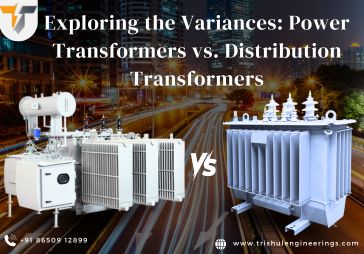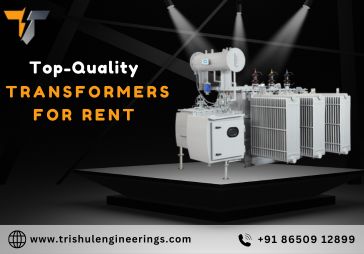- Distribution Transformers: Bringing Power to Your Doorstep
- Power Transformers: The Backbone of Transmission
- Difference between Power Transformer and Distribution Transformer
- Distribution Transformer Manufacturer: The Role of Expertise
- Why Trishul Engineering Corporation Stands Out:
- Conclusion: Trishul Engineering Corporation – The Epitome of Excellence
Transformers are essential components of the electrical grid, playing a crucial role in transmitting and distributing electrical energy. Among the various types of transformers, two prominent categories are power transformer and distribution transformer. Understanding the differences between these two is vital for ensuring an efficient and reliable power supply. In this blog, we will explore the difference between power transformers and best distribution transformer, shedding light on their distinct functions and characteristics.
Best Distribution Transformer: Bringing Power to Your Doorstep
On the other hand, distribution transformers play a critical role in bringing electrical power to end-users, serving as the final link between the transmission network and consumers. Unlike power transformers, distribution transformer operates at lower voltage levels and are strategically placed near consumption points to minimize power losses and enhance efficiency.
Key Characteristics of Best Distribution Transformer:
1. Low Voltage Operation:
Distribution transformers operate at lower voltage levels, typically ranging from 4 kV to 33 kV, ensuring safe and efficient power delivery to residential, commercial, and industrial areas.
2. Compact Size:
These transformers are more compact compared to power transformers, making them suitable for installation in urban and densely populated areas where space is limited.
3. Lower Power Ratings:
It has lower power ratings compared to power transformers, usually ranging from a few kVA to 10 MVA, catering to localized power distribution needs.
Best Distribution Transformer: The Backbone of Transmission
Distribution Transformer serves as the backbone of the electrical transmission network. These transformers primarily operate at high voltages, converting electrical energy between different voltage levels for efficient long-distance transmission. Their key purpose is to step up voltage for transmission over long distances and then step it down for distribution and consumption.
Key Characteristics of Best Power Transformer:
1. High Voltage Operation:
Power transformers are designed to handle high voltage levels, typically ranging from 138 kV to 765 kV, enabling efficient transmission over extensive distances.
2. Large Power Ratings:
These transformers are built to handle large power ratings, often exceeding 200 MVA, making them suitable for bulk power transmission.
3. Core and Shell Design:
Power transformers typically employ a core and shell design, allowing them to efficiently handle the high magnetic flux associated with high voltage operations.
Difference between Power Transformer and Distribution Transformer
Location in the Grid:
- Power transformers are typically located at the substations connected to the power generation plants and are responsible for elevating the voltage for long-distance transmission.
- Distribution transformer are strategically placed closer to the end-users and ensuring reliable power supply to homes and businesses.
Usage Scenario:
- The transmission network employs power transformers, facilitating the transfer of bulk power over extensive distances.
- Power distribution systems utilize distribution transformers in the final stages to step down voltage for local consumption.
Design and Construction:
- Power transformers are often larger in size, employing a core and shell design to handle the high voltages associated with transmission.
- Distribution transformer are more compact, utilizing a simpler core and coil design suitable for lower voltage operations.
Distribution Transformer Manufacturer: The Role of Expertise
When it comes to ensuring the reliability and efficiency of transformers, the choice of a manufacturer is crucial. Trishul Engineering Corporation emerges as a prominent player in the field of Distribution Transformer, offering unparalleled expertise and a commitment to quality.
Best Distribution Transformer: Why Trishul Engineering Corporation Stands Out
- Experience and Expertise: With years of experience in the industry, Trishul Engineering Corporation has honed its expertise in manufacturing distribution transformers.
- Cutting-edge Technology: The company leverages cutting-edge technology to manufacture transformers that meet the highest industry standards, ensuring efficiency and reliability.
- Customization Options: Trishul Engineering Corporation understands the diverse needs of its clients and provides customization options to specific requirements.
Conclusion: Trishul Engineering Corporation – The Epitome of Excellence
In conclusion, the differences between power transformer and distribution transformer lie in their voltage levels, applications, and designs. Power transformers are the workhorses of the transmission network, handling high voltages for long-distance power transfer. On the other hand, distribution transformers focus on delivering power to end-users efficiently and safely at lower voltage levels.
In the realm of transformer manufacturing, Trishul Engineering Corporation stands out as a reliable and innovative player. With a commitment to quality, cutting-edge technology, and a customer-centric approach, Trishul Engineering Corporation has established itself as the best distribution transformer manufacturer. Choosing a reputable manufacturer like Trishul ensures that the transformers meet stringent quality standards, contributing to a robust and reliable electrical infrastructure.


